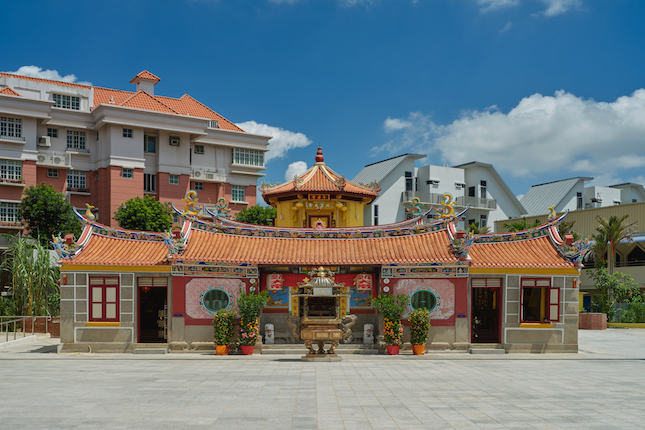Hougang Tou Mu Kung (后港斗母宫) is the oldest temple in Singapore dedicated to the Nine Emperor Gods. The deities are known in Hokkien as Kew Ong Yah, which also gives rise to believers referring to the temple as the Kew Ong Yah temple (九皇大帝庙). The temple started in 1902 as a shrine at Lim Loh Village (present-day Wolskel Road), with incense ash brought from another Nine Emperor Gods temple in Penang. The temple’s early records showed that its worshippers were from various Chinese dialect groups including Hokkien, Teochew, Hainanese and Hakka.
In 1919, businessman Ong Chwee Tow donated the present site for the building of a new temple. The temple was completed in 1921 and originally designed in traditional Hokkien architectural style, with features such as pronounced curvatures of the roof ridges. Teochew architectural features such as straighter roof ridges were added in subsequent renovations and a permanent opera stage was erected in 1925.
The temple is known for its Nine Emperor Gods festival held during the ninth month of the Chinese lunar calendar when the deities are believed to descend from the heavens to earth. The festival begins on the last day of the eighth lunar month with a procession from the temple to Sungei Serangoon to invite the deities into the temple. The deities would be sent off at the river with a grand procession on the last day of the festival.
In 2005, Hougang Tou Mu Kung was gazetted as a National Monument in recognition of its historical and social significance for both Hougang and the nation. Extensive works were launched in 2016 to preserve the building’s heritage and to better serve its worshippers. The main temple building was restored while new annexes, including a multi-storey block and an underground carpark, were added.
From National Monuments to memories of diverse communities who call Hougang home, these three thematic trails are designed to bring you on a journey of discovery. Explore Hougang beyond its modern housing estates, trace its stories through its built heritage, and get to know how it transformed from kampongs into the suburb it is today.
Explore the Suggested Short Trail Routes:
- Landmarks of Hougang, 1 hour with public transport
- Architectural Gems, 1 hour 45 min with public transport
- Institutions of Service, 1 hour 30 min with public transport
Downloads
Trail Booklet and Trail Maps
- Hougang Heritage Trail Booklet
- Hougang Heritage Trail Map - English
- Hougang Heritage Trail Map - Chinese
- Hougang Heritage Trail Map - Malay
- Hougang Heritage Trail Map - Tamil














